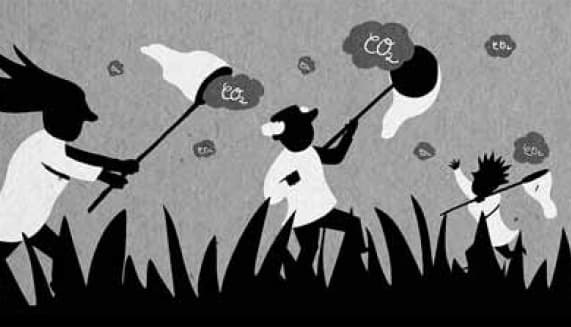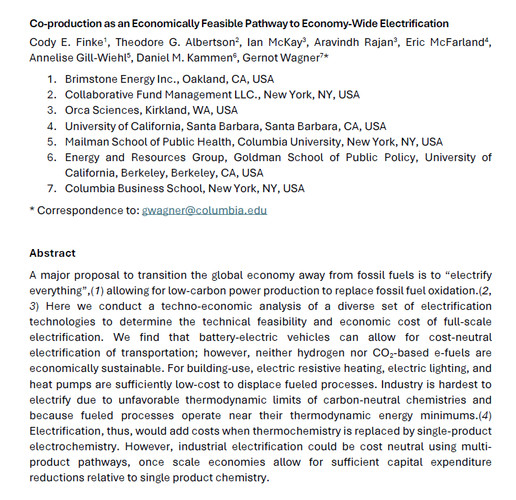Bailing out the planet
Book excerpt
By Gernot Wagner and Martin L. Weitzman, excerpted from Climate Shock: The Economic Consequences of a Hotter Planet in the Milken Institute Review.

Credit: Oliver Weiss/Milken Institute Review
In June 1991 and with a year to go, preparations for the Rio Earth Summit were in full swing. “Sustainability” was in vogue. Who could disagree that humanity ought to “ensure that it meets the needs of the present without compromising the ability of future generations to meet their own needs”?
The excitement was palpable. It might still be possible to achieve sustainable development “by the year 2000 and beyond,” as the General Assembly of the United Nations had called for. There was only one problem: the Earth’s atmosphere had already warmed by more than 0.5°C (0.9°F) since the industrial revolution, with all trends pointing higher still.
China had just emerged from a decade of market-based economic reforms and was on the cusp of pulling hundreds of millions of its citizens out of abject poverty. The best technologies available at the time meant that China would spend the next decade largely duplicating what the United States, Europe and others had done: Burn coal, oil, and natural gas—mostly coal—and dump the resulting carbon dioxide into the air, further heating the planet. There was only so much President George H. W. Bush could do by signing the 1992 Earth Summit declaration “Agenda 21,” other than give heartburn and a rallying cry to future generations of right-wing conspiracy theorists. But all that was still a year out. President Bush and over a hundred fellow heads of state would not fly to Rio until June 1992.
Meanwhile, Mount Pinatubo, a volcano in the Philippines that had been dormant for over 400 years, began to rumble on April 2, 1991. Two months later, volcanic activity went into overdrive, culminating in a final explosion on June 15. Ash, rocks and lava buried the surrounding area. To make things worse, Typhoon Yunya slammed the area that very same day. The resulting floods combined with the effects of the explosion displaced over 200,000 Filipinos. Over 300 died.
The costs were all too real. But so were the benefits: As a direct result of the volcanic eruption, global temperatures temporarily decreased by about 0.5°C (0.9°F), wiping out the entire temperature effects of human-caused global warming up to that point. The reduction in temperatures hit its peak just around the time of the Rio Earth Summit a year later.
Mount Pinatubo did all that by spewing some 20 million tons of sulfur dioxide into the stratosphere. That amount counteracted the global warming effect of around 585 billion tons of carbon dioxide that humans had managed to put into the atmosphere by then. (Now, more than two decades later, the total tonnage of carbon dioxide added to the atmosphere is around 940 billion, and still climbing.)
The leverage ratio of sulfur to carbon dioxide in terms of what’s called “geoengineering” is enormous. The sulfur dioxide released by Mount Pinatubo reduced temperatures by about the same amount as 30,000 times as much carbon dioxide increased them. It’s tempting to draw a link to nuclear technology: Little Boy, the atomic bomb dropped over Hiroshima, had roughly 5,000 times as much power as the same mass of traditional explosives.
The comparison to nuclear technology also suggests the possible path ahead. The Titan II intercontinental ballistic missile was developed just 15 years after Little Boy was dropped. It could carry a warhead with more explosive power than all the bombs dropped in World War II combined, including Little Boy. If geoengineering advanced even a fraction as quickly, it’s hard to imagine the technologies that could become available to counteract atmospheric warming by carbon dioxide. Even using today’s technology, a more targeted geoengineering intervention could possibly achieve leverage ratios near a million-to-one – that is, one ton of cooling material could offset the warming caused by one million tons of carbon dioxide.
The similarities to the leverage of nuclear bombs are striking. But there’s an important difference: Both nuclear and conventional explosives destroy, whereas geoengineering has the potential to do immense good.
The Promise and Problems of Geoengineering
Without considering the costs and lives lost, Mount Pinatubo’s effect on global temperature was presumably a good thing. If we could wipe out two centuries of accumulated, human-caused global warming by turning a knob, why not go for it?
There are a few problems with that simple picture. Mount Pinatubo decreased the indirect, if all-too-real, effects of carbon dioxide in the atmosphere: The 20 million tons of sulfur dioxide created a sunshade that dimmed the radiation from the sun by about 2 to 3 percent throughout the following year. But the eruption did nothing to counteract the direct effects of carbon pollution, like turning the oceans more acidic as they absorbed added carbon dioxide.
Moreover, as much as participants in the 1992 Earth Summit were presumably heartened by the cooling impact of Mount Pinatubo, they must have been distraught by the accompanying decrease in stratospheric ozone that protects us from ultraviolet light. Combine the volcano’s sulfur dioxide and other gunk with certain types of pollution that we humans send into the atmosphere, and you may get ozone depletion of the type that gave us the ozone hole over the South Pole—but now the depletion could occur over the tropics as well.
If that weren’t enough, Mount Pinatubo is also invariably blamed for weather extremes -- flooding along the Mississippi River in 1993 and for droughts elsewhere. The volcanic eruption coincides with the beginning of a remarkably global dry spell lasting about a year. Direct links are difficult to establish, but that only makes it more problematic. If we could draw a direct line from Mount Pinatubo to sub-Saharan African droughts, we’d at least know what to hold responsible. Without that link, speculation runs rampant.
What if, instead of a volcano, the cause of the climate change had been a group of scientists launching an experiment to counteract two centuries of global warming just in time for the Rio Earth Summit?
One can assume that such an experiment could have been designed in a way to avoid the 200,000 evacuations and 300 deaths. But even without those all-too-direct effects of the eruption, it would have been hard to imagine a university’s institutional review board, the group charged with overseeing the safety of research, approving the experiment. It’s often hard enough to get approval for a simple e-mail survey, asking test subjects to deploy their computer mice and answer a few benign questions. Now imagine intentionally injecting the stratosphere with tiny, custom-designed particles to mimic the effects of Mount Pinatubo, with the express purpose of altering the global climate.
Forget institutional review boards. The public might have a word or two to say here—as it should. Even if the only effect of releasing particles into the atmosphere were to cool the atmosphere with no regional difference whatsoever – an implausible outcome--it would still be hard to agree on the “right” amount of temperature-lowering.
If you live at higher latitudes, a few degrees of warming might not be all that bad for you personally. Why dial that back? On the other hand, if you live in Cape Town, San Francisco or along the Mediterranean, you pretty much enjoy the most stable, ideal climates anywhere on Earth. Why change that?
And if we did dial it back, where should we stop? Pre-industrial levels seem like a reasonable target. But today seems fine, too.
There is no right answer to any of these questions, other than to say that we would need strong, global institutions and well-formed governance processes to make these decisions in a way that considers a breadth of voices in a democratic, well-informed way. But we don’t have a global government. Instead, we need to work with what we have. That’s a fragmented global governance complex with imperfect representation and even more imperfect decision processes. Decision-making in Washington, D.C., may be at a standstill, but at least there is a formal process to make decisions. On a global level, we have yet to create the institutions that allow us to even have the conversation.
Fortunately, we are still far from having to make decisions about deploying geoengineering. Unfortunately, the failure to deal with global warming now is pushing us relentlessly in that direction.
Continue reading in the Milken Institute Review.
Excerpted from “Climate Shock: The Economic Consequences of a Hotter Planet” by Gernot Wagner and Martin L. Weitzman.


